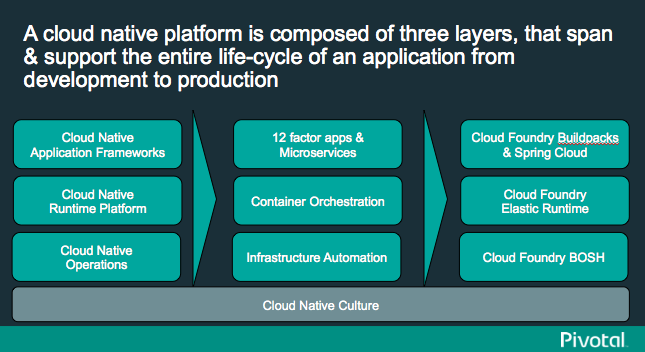

- #CLOUD NATIVE JAVA VERSUS CLOUD FOUNDRY THE DEFINITIVE GUIDE HOW TO#
- #CLOUD NATIVE JAVA VERSUS CLOUD FOUNDRY THE DEFINITIVE GUIDE UPDATE#
- #CLOUD NATIVE JAVA VERSUS CLOUD FOUNDRY THE DEFINITIVE GUIDE ANDROID#
- #CLOUD NATIVE JAVA VERSUS CLOUD FOUNDRY THE DEFINITIVE GUIDE SOFTWARE#
In that message’s spirit, we started reorganizing the SAP Cloud Platform cockpit to bring the services more in the developers’ focus. To reiterate: The value of the SAP Cloud Platform comes from its services the runtimes are the connective tissue that binds the services with each other while creating business value. All SAP Cloud Platform services can be found here. With this technical service, you can add these capabilities to your application with a simple REST request. The Document Information Extraction service uses machine learning to extract information from documents such as bills and recipes. The Workflow Management service can create flexible workflows for your processes and define business rules. The Launchpad service is used to provide access to all your business apps via the Fiori Launchpad.

Such services are, for example, the destination and connectivity services that help you to connect your cloud apps with cloud solutions (SAP S/4 HANA Cloud, SAP SuccessFactors, non-SAP system…) and on-premise solutions (SAP S/4 HANA, SAP NetWeaver…). To provide high business value, the SAP Cloud Platform offers many business services that make life easy for SAP developers. The value of a platform heavily depends on the value of the services offered on this platform. Services in SAP Cloud PlatformĪt last years’ TechEd, SAP’s CTO Jürgen Müller announced that the Business Technology Platform’s goal is “ to provide the fastest way to turn data into business value.” This goal also applies to the SAP Cloud Platform as it is part of the Business Technology Platform. As a consequence, the manifest becomes more verbose. More mightily platforms, such a Kyma, on the other side, offer many tuning parameters to configure the project setups and apply best practices manually. Platforms that make more assumptions of the hosting setup (such as Cloud Foundry) typically offer fewer configuration parameters and offer a more simplistic manifest. Typical vectors here are the compute resources (memory size, disk size, CPU shares, etc.), the bound service instances, the attached volumes, the environment variables, and so on. While this format is not always easy to write, it is significantly easier to read than other formats such as JSON.īoth manifest file types are used to specify the respective parameters that the platform can offer. As the name suggests, both manifests use YAML as the file format. While there is a clear difference in the number of available parameters and their effects, there are also many similarities between the deployment.yaml of Kubernetes and Kyma and the mta.yaml file of the deploy service of SAP Cloud Platform, Cloud Foundry. The manifest of the SAP Cloud Platform runtimes contain metadata as well, but they use different properties than the example from above. They usually include metadata about projects such as the project ID, the project name, and the project’s packages or dependencies.
#CLOUD NATIVE JAVA VERSUS CLOUD FOUNDRY THE DEFINITIVE GUIDE ANDROID#
They are used outside of the SAP-World (e.g., Android App Manifests, Node.js package.json) and inside the SAP-World ( SAPUI5 manifest.json).

#CLOUD NATIVE JAVA VERSUS CLOUD FOUNDRY THE DEFINITIVE GUIDE SOFTWARE#
Manifest files are quite common in software development. For this consumption, each runtime later needs to define the compute resources and bound service instances. I dockerized the entire application and uploaded it to DockerHub, from where it can be consumed by both cloud-native runtimes. This approuter consumes two SAP Cloud Platform services (destination services and xsuaa services). I created a simple SAPUI5 web app that is embedded in an approuter, which is a Node.js application. In the screenshot above, you can see that I deployed a SAPUI5 sample app to both runtimes – Kyma and Cloud Foundry.
#CLOUD NATIVE JAVA VERSUS CLOUD FOUNDRY THE DEFINITIVE GUIDE HOW TO#
And second, you’ll learn what kinds of directives exist for each manifest file and how to “translate” them to each other.Ī dockerized SAPUI5 sample app running on the Cloud Foundry and the Kyma runtime First, it will help you understand the fundamental differences between the Cloud Foundry and the Kyma runtime.
#CLOUD NATIVE JAVA VERSUS CLOUD FOUNDRY THE DEFINITIVE GUIDE UPDATE#
Update 6th Nov 2020: I added a more elegant way to deploy to the Kyma Runtime

In other words, I compare the deployment.yaml of Kyma with the mta.yaml file of SAP’s Cloud Foundry Deploy service. In this Cloud-Native Lab post, I’ll compare the manifest files of two runtimes within SAP Cloud Platform – the Cloud Foundry and the Kyma runtime.


 0 kommentar(er)
0 kommentar(er)
